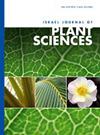Crop water stress index relationship with soybean seed, protein and oil yield under varying irrigation regimes in a Mediterranean environment
IF 0.9
4区 生物学
Q4 PLANT SCIENCES
引用次数: 1
Abstract
A two-year field experiment was conducted to determine the effect of water stress, including Crop Water Stress Index (CWSI), on seed, protein and oil yields, for two hybrids of drip-irrigated soybean in Central Greece. The experiment was set up as a split plot design with four replicates, five main plots (irrigation treatments) and two sub-plots (soybean hybrids, ‘PR91M10’ and ‘PR92B63’). Irrigation was applied to provide 100, 75, 50 and 25% of the crop evapotranspiration needs and 0% non-irrigated. Biomass weight, seed yield, oil and protein concentration were measured after harvest. To compute CWSI, lower and upper baselines were developed based on the canopy temperature measurements of I100 and I0 treatments, respectively. Deficit irrigation had a significant effect on biomass, seed, protein and oil yields. Hybrid PR92B63 was more responsive to irrigation and showed higher biomass, seed protein and oil yields, while the more sensitive hybrid PR91M10 had the ability to maintain productivity with increasing degrees of water stress. The rain-fed treatments significantly reduced biomass production and seed yield compared with the fully-irrigated ones. The highest and the lowest protein and oil yields were obtained in the I100 and I0 treatments respectively in both years and cultivars. Statistically significant exponential relationships were determined between CWSI and biomass, seed, protein and oil yields. Generally, CWSI could be used to measure crop water status and to improve irrigation scheduling of the crop and 0.10 for PR92B63 and 0.19 for PR91M10 could be offered as threshold values under the climatic conditions of the region.地中海不同灌溉制度下作物水分胁迫指数与大豆种子、蛋白质和油脂产量的关系
在希腊中部进行了一项为期两年的田间试验,以确定水分胁迫(包括作物水分胁迫指数(CWSI))对两种滴灌大豆杂交品种种子、蛋白质和油脂产量的影响。试验采用分割小区设计,设4个重复,5个主小区(灌溉处理)和2个小小区(杂交大豆PR91M10和PR92B63)。灌溉可提供作物蒸散需求的100%、75%、50%和25%,不灌溉可提供作物蒸散需求的0%。收获后测定生物量、籽粒产量、油脂和蛋白质浓度。为了计算CWSI,分别以I100和I0处理的冠层温度数据为基础建立了下基线和上基线。亏缺灌溉对生物量、种子产量、蛋白质产量和油料产量均有显著影响。杂交品种PR92B63对灌溉响应更强,生物量、种子蛋白和油料产量更高,而杂交品种PR91M10对灌溉更敏感,在水分胁迫程度增加的情况下仍能保持产量。与全灌处理相比,雨养处理显著降低了生物量产量和种子产量。在年份和品种上,I100和I0处理的蛋白质和油脂产量分别最高和最低。CWSI与生物量、种子、蛋白质和油脂产量呈显著指数关系。一般而言,CWSI可用于测量作物水分状况和改善作物灌溉调度,在该地区气候条件下,PR92B63和PR91M10的阈值分别为0.10和0.19。
本文章由计算机程序翻译,如有差异,请以英文原文为准。
求助全文
约1分钟内获得全文
求助全文
来源期刊

Israel Journal of Plant Sciences
生物-植物科学
CiteScore
1.90
自引率
0.00%
发文量
17
审稿时长
>12 weeks
期刊介绍:
The Israel Journal of Plant Sciences is an international journal of extensive scope that publishes special issues dealing with all aspects of plant sciences, including but not limited to: physiology, cell biology, development, botany, genetic
 求助内容:
求助内容: 应助结果提醒方式:
应助结果提醒方式:


